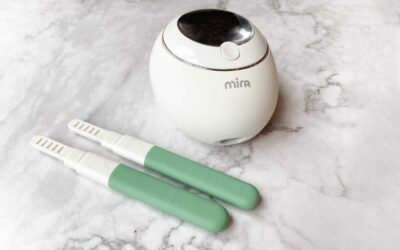This article is for postpartum/breastfeeding moms who want to use a natural method of family planning (no pills, no devices, no barriers) and need a review of their options.
I’m a Marquette Method instructor, and I regularly help couples decide between two different options:
- The Lactational Amenorrhea Method (LAM)
- The Marquette Method of NFP Breastfeeding Protocols.
Both methods of pregnancy avoidance fall into the category of natural family planning (NFP), a.k.a. fertility awareness-based methods or FABMs.
And—spoiler alert—they’re both great options.
- Both are easy to learn and relatively easy to use.
- Both are equally effective if practiced correctly.
Even though I teach Marquette, there are times that I advise couples to consider using LAM, for at least as long as they qualify for it.
So, if you’re hesitant about taking a hormonal contraceptive while you’re breastfeeding, rest assured that it is possible to delay pregnancy without it.
Consider this a crash course in postpartum NFP.
Need help keeping the abbreviations straight? Check out our of glossary of NFP/FABM acronyms.
Let’s begin with effectiveness rates.
For obvious reasons method effectiveness is the #1 consideration for most women and couples considering NFP during the postpartum time.
Effectiveness Rates: Marquette Method Breastfeeding Protocols & Lactational Amenorrhea Method:
- The Marquette Method of NFP breastfeeding protocols are 98% effective with perfect use and 92% effective in typical use (Bouchard, Fehring, & Schneider, 2013).
- The Lactational Amenorrhea Method (LAM) is at least 98% effective in the first 6 months of baby’s life (Rogers, 1997; Tommaselli, Guida, Palomba, Barbato, & Nappi, 2000; World Health Organization, 1998).
My goal is to give you the information you need to make an informed choice about which of these two options might be good fit for you, right now, at this point in your life.
Table of Contents
- The Biology of Breastfeeding and Fertility
- Lactational Amenorrhea: A Natural Way to Avoid Pregnancy
- Lactational Amenorrhea Method (LAM)
- Benefits of LAM
- LAM and Pumping Breastmilk
- Some Moms Find LAM Practical. Others Don’t.
- The Marquette Method Breastfeeding Protocols
- How the Marquette Method Breastfeeding Protocols Work
- Choosing Between LAM and Marquette
- References
The Biology of Breastfeeding and Fertility
Let’s start with the basics.
Breastfeeding affects your fertility.
When your baby nurses, your body produces prolactin. Prolactin prompts your body to produce more breastmilk, but elevated prolactin doesn’t just affect your milk supply—it also influences your fertility.
Breastfeeding women with sufficient levels of prolactin circulating in their body experience a delayed return to fertility.
Not to introduce too many acronyms and jargon, but this happens because prolactin suppresses the production of gonadotropin-releasing hormone (GnRH) which in turn suppresses follicle stimulating hormone (FSH) and luteinizing hormone (LH).
Without these hormones, no follicles are stimulated to pick up and develop an oocyte (immature egg) from the ovary and turn into an ovum (mature egg).
Without a mature egg, ovulation cannot occur.
The chain reaction of prolactin, GnRH and FSH is fascinating (I wrote a chapter about it in my Marquette Method Breastfeeding Manual) … but if you’re an overtired mom reading this article, it’s enough to know that the presence of prolactin will most likely suppress the regular, cyclical functioning of your reproductive system—at least for a while.
For as long as prolactin continues to suppress egg development, breastfeeding mothers remain naturally infertile.
Breastfeeding is nature’s way of ensuring that mothers can space out their pregnancies enough to be able to care for and nourish their babies before their next pregnancy.
Most breastfeeding mothers experience a delayed return to fertility.
But the crucial question of how long fertility is suppressed depends on a lot of factors, the big ones are
- how much you breastfeed, and
- how often you breastfeed.
At Vitae Fertility we’ve helped thousands of women manage their fertility naturally through the breastfeeding transition. We know firsthand that every woman has a different experience.
Some breastfeeding women experience only a couple of months of infertility before their fertility returns. Other women experience 24+ months of lactational amenorrhea.
Note: Lactational amenorrhea is the medical term for the time in which breastfeeding suppresses menstruation—lactational means “breastfeeding,” and amenorrhea means “the absence of menstruation.”
Lactational Amenorrhea: A Natural Way to Avoid Pregnancy
Some things are consistent. Research going all the way back to the late 1980s has found consistently that women who are exclusively breastfeeding their baby generally do not see a return to fertility until at least the 6-month mark.
This is the research which underpins LAM. It has years of high-quality, evidence-based research that supports its effectiveness rates (Kennedy & Visness, 1992; Short, Lewis, Remfree & Shaw, 1991).
My goal is not to teach you how to use LAM, but to inform you of about the basic approach.
Then I’m going to compare LAM’s approach to postpartum family planning with the Marquette Method’s approach, which is significantly different.
Lactational Amenorrhea Method (LAM)
The Lactational Amenorrhea Method of is relatively simple.
To use the method, you simply need to be able to answer “yes” to each of the following three criteria—this is called the “LAM algorithm.”
1. Have you remained in amenorrhea (no period) since the birth of your baby and also have not experienced any vaginal bleeding since your lochia dried up? For the purposes of determining LAM eligibility, for breastfeeding women any bleeding that occurred in the first 56 days postpartum is not considered menstrual bleeding.
2. Are you exclusively breastfeeding your baby? “Exclusively breastfeeding” means your baby needs to be getting all his/her nutrition from breastfeeding and does not drink any formula or eat any solid food. Additionally, “exclusively breastfeeding” means allowing your baby to nurse at the breast on demand, day and night—never going longer than 4 hours between breastfeeding sessions during the day and 6 hours between breastfeeding sessions at night.
3. Is your baby less than 6 months old?
For as long as the answer remains “yes” to all three of these questions, a breastfeeding woman can expect the LAM method to be 98% effective in avoiding pregnancy (Kennedy, Rivera & McNeilly, 1988).
Put another way, this means that she has only a 2% (1 in 50) chance that intercourse while eligible for LAM will result in a pregnancy.
For as long as a woman qualifies for LAM, no abstinence is required.
Not sure if you qualify? By all means get in touch. (I’m know that in real life human fertility is complicated, and sometimes what seem like easy questions don’t have easy answers.) I’m well-versed in the research surrounding LAM and I can help you discern whether or not LAM is currently an option for you.
Benefits of LAM
One of the biggest benefits of LAM, obviously, is that no abstinence is required.
If you used another form of NFP or FABM before becoming pregnant, LAM can be a nice break from urine testing, checking symptoms, and/or charting.
As long as you fit the criteria, you can engage in intercourse on any day and still only have a 2% chance of becoming pregnant.
Alas, all good things must come to an end.
At some point all women will need to transition from LAM to another family planning method if they want to continue avoiding pregnancy.
Some situations that may cause you to fall out of the LAM criteria are:
- If your baby ever goes longer than 6 hours without nursing (even just once), you’re no longer eligible for LAM.
- Women who experience any bleeding after 56 days postpartum will need to transition to another method (even if you don’t think the bleed you experienced was a menstrual bleed)
- And finally, the method applies only up until 6 months postpartum, so when your baby reaches his or her half-birthday, you’ll need to switch to another method of pregnancy avoidance, if you still want to avoid pregnancy.
LAM and Pumping Breastmilk
If you go back to work before your baby is 6 months old, or if you are pumping rather than nursing, you may still decide to rely on LAM method. There are additional considerations to follow, and the method effectiveness drops to 94.8% (Valdés, Labbok, Pugin, & Perez, 2000).
Please reach out if you want to know more about using LAM and/or the Marquette Method while pumping your breastmilk.
Some Moms Find LAM Practical, but Others Don’t
Most women who are breastfeeding aren’t doing it because they want to avoid pregnancy for the first 6 months of their baby’s life—they’re doing it because it’s a practical way to feed their baby, and it’s a nice opportunity to bond with their baby.
For some women, breastfeeding is just the economical choice. Babies have to eat. Formula is expensive.
To breastfeed or not is very much a personal choice, and it’s not one that anyone can make except you.
Many women love LAM and practice it successfully with each of their children. For many women the style of breastfeeding that LAM requires perfectly matches the type of breastfeeding relationship they always wanted to have with their baby, and the fertility-suppressing side effect of exclusive breastfeeding is just a happy and convenient side effect. Adding a new baby to the mix can complicate things and if breastfeeding is coming easily for you, then LAM can really simplify the NFP aspect of your life.
That said, as I’m sure you know, not all women find breastfeeding easy.
You might intend to practice LAM, only to find out that breastfeeding got off to a rough start, and your baby didn’t cooperate as planned.
In these cases, most women still want to breastfeed their baby, but perhaps not as intensively or frequently as required make them eligible for LAM.
Some babies tend to sleep long stretches through the night, and not a lot of mothers want to wake their sleeping baby just to ensure they continue to fit the LAM criteria.
Breastfeeding, but Not Exclusively?
Try the Marquette Method Breastfeeding Protocols.
A lot of breastfeeding women, for a wide variety of reasons, just don’t (or can’t) breastfeed in the way that LAM prescribes.
For these women, the Marquette Method Breastfeeding Protocols are a great choice. A recent review of postpartum NFP effectiveness studies showed the Marquette Method was the most effective method for postpartum, breastfeeding women for the first 12 months postpartum and the first 6 cycles postpartum (Redmond et al., 2022).
The main differences between LAM and the Marquette Method is that in order to qualify for the Marquette Method Breastfeeding Protocols you simply need to be breastfeeding, and there’s no 6-month cutoff.
Here are some key facts about the Marquette Method Breastfeeding Protocols:
All lactating mothers welcome. Once a day, twice a day, all-day-long … any kind of breastfeeding means you’re still eligible to follow Marquette’s protocols. You can expect them to be just as effective, regardless of what your breastfeeding habits are.
Works while pumping. The Marquette Method Breastfeeding Protocols still work if you’re pumping some of the time, or all of the time, or not pumping at all.
Works if you’ve been blessed with a good sleeper. Marquette works if your baby is sleeping through the night (and it works if your baby wakes you up all night long to nurse, too).
Works if you are supplementing with formula. It works if your baby has been fed some formula once or twice, gets formula regularly, and or has started solids.
Works even after postpartum bleeding (period or not). Your Marquette instructor can help you to figure out what phase of fertility you’re in and can teach you the appropriate protocol to follow.
How Do the Marquette Method Breastfeeding Protocols Work?
Unlike LAM, the Marquette Method of NFP is not based on the likelihood of your fertility staying away. Instead, it’s based on direct, daily monitoring of your body’s actual hormone levels.
Because at some point, no matter how much you breastfeed, the fertility-suppressing effect of prolactin wanes, and your GnRH levels will begin to rise.
This rise in GnRH will begin a chain reaction of hormone production, which eventually results in your body returning to fertility.
The basic concept of the Marquette Method for breastfeeding women is that the Clearblue fertility monitor (which the Marquette Method uses as a tool to measure your hormone levels) tracks your estrogen and LH levels on an almost-daily basis.
By measuring these hormone levels daily, you can identify hormone patterns. This will give you enough warning that your body is returning to fertility to begin abstaining in time to avoid pregnancy.
Choosing Between LAM and Marquette
Breastfeeding women, you have options.
It does not have to be an either/or. You can do both.
Many women choose to rely on LAM for as long as they qualify. It’s effective, it’s (relatively) easy, and it’s free. For as long as it works for your life and your baby cooperates, it’s a great option for new moms.
Some women start practicing the Marquette Method of NFP only once they no longer qualify for LAM. The effectiveness rates for LAM and Marquette are basically the same, so choosing between them really means deciding what’s going to be the most comfortable method for you.
LAM requires no abstinence (for as long as you fit the criteria), and the Marquette Method may or may not require periods of abstinence, depending on your hormone readings.
Some women like the added assurance (and control) that testing with the Marquette Method gives them and choose to use the Marquette Method’s Breastfeeding Protocols before they resume intercourse after having their baby, even if they do still qualify for LAM.
Marquette has an excellent protocol during “cycle zero” — tailored specifically to women who haven’t yet returned to fertility after the birth of their baby. In those tricky first few postpartum cycles, when the woman returns to fertility, Marquette has a different protocol for women to follow. Once their cycles return to a normal cadence, women begin following the Marquette regular cycles protocols.
There’s no “right” or “wrong” answer about which method is the best. Couples need to make this choice themselves. Now that the information has been laid out for you, the decision is yours.
Still have questions? I’m always here to help.
I’m a Marquette Method Instructor, but I am also well-versed in the Lactational Amenorrhea Method of pregnancy avoidance.
The Marquette Method of NFP is a very popular option for breastfeeding mothers—approximately 90% of our clients switch to Marquette during a breastfeeding transition, some of them with brand-new babies, some after they no longer qualify for LAM, and others switching from a mucus-based method of NFP that wasn’t working for them in the postpartum phase.
I offer free consultations and would be glad to help you to help you decide which method of family planning is likely to be a good fit for you, taking into consideration your specific fertility situation.
References:
Bouchard, T., Fehring, R. J., & Schneider, M. (2013). Efficacy of a new postpartum transition protocol for avoiding pregnancy. Journal of the American Board of Family Medicine, 26(1), 35–44. https://doi.org/10.3122/jabfm.2013.01.120126
Kennedy, K. I., Rivera, R., & McNeilly, A. S. (1989). Consensus statement on the use of breastfeeding as a family planning method. Contraception, 39(5), 477–496. https://doi.org/10.1016/0010-7824(89)90103-0
Pérez, A., Labbok, M. H., & Queenan, J. T. (1992). Clinical study of the lactational amenorrhoea method for family planning. Lancet (London, England), 339(8799), 968–970. https://doi.org/10.1016/0140-6736(92)91538-j
Redmond, J. J., Jensen, E. T., Stanford, J. B., Greene, M. E., Kennedy, E., & Urrutia, R. P. (2022). Effectiveness of Fertility Awareness-Based Methods for Pregnancy Prevention During the Postpartum Period. Contraception, S0010-7824(22)00157-3. Advance online publication. https://doi.org/10.1016/j.contraception.2022.06.007
Rogers, I. S. (1997). Lactation and fertility. Early Human Development, 49, S185–S190. https://doi.org/10.1016/S0378-3782(97)00063-7
Tommaselli, G. A., Guida, M., Palomba, S., Barbato, M., & Nappi, C. (2000). Using complete breastfeeding and lactational amenorrhoea as birth spacing methods. Contraception, 61(4), 253–257. https://doi.org/10.1016/S0010-7824(00)00101-3
Valdés, V., Labbok, M. H., Pugin, E., & Perez, A. (2000). The efficacy of the lactational amenorrhea method (LAM) among working women. Contraception, 62(5), 217–219.
World Health Organization. (1998). The World Health Organization multinational study of breast-feeding and lactational amenorrhea. II. Factors associated with the length of amenorrhea. Fertility and Sterility, 70(3), 461–471. https://doi.org/10.1016/S0015-0282(98)00191-5





